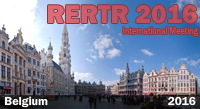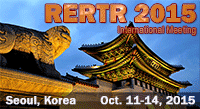Examples of LEU Conversion Analyses in the RERTR Program
THE WHOLE- CORE LEU U3SI2-AL
FUEL DEMONSTRATION IN THE
30-MW OAK RIDGE RESEARCH REACTOR
M. M. Bretscher and J. L. Snelgrove
ABSTRACT
The ORR Whole-Core LEU Fuel Demonstration, conducted as part of the U.S. Reduced Enrichment Research and Test Reactor Program, has been successfully completed. Using commercially-fabricated U3Si2-Al 20%-enriched fuel elements (4.8 g U/cc) and fuel followers (3.5 g U/cc), the 30-MW Oak Ridge Research Reactor was safely converted from an all-HEU core, through a series of HEU/LEU mixed transition cores, to an all-LEU core. There were no fuel element failures and average discharge burnups were measured to be as high as 50% for the standard elements and 75% for the fuel followers. Experimental results for burnup-dependent critical configurations, cycle-averaged fuel element powers, and fuel-element-averaged 235U burnups validated predictions based on three-dimensional depletion calculations. Calculated values for plutonium production and isotopic mass ratios as functions of 235U burnup support the corresponding measured quantities. In general, calculations for 60Co and 198Au reaction rate distributions, differential and integral control rod worths, prompt neutron decay constants, and isothermal temperature coefficients were found to agree with corresponding measured values. Experimentally determined critical configurations for fresh HEU and LEU cores radially reflected with water and with beryllium are well-predicted by both Monte Carlo and diffusion calculations.
![]() PDF version available
PDF version available
This document is split in downloadable PDF sections.
| TABLE OF CONTENTS AND ABSTRACT (48 KB) | Page |
| 1. INTRODUCTION (Chapters 1 to 6 in one file: 1.04 MB) | 1 |
| 2. THE 30-MW OAK RIDGE RESEARCH REACTOR (Chapters 1 to 6 in one file: 1.04 MB) | 3 |
| 2.1 Description of Facility | 3 |
| 2.2 Description of Fuel Elements | 3 |
| 2.3 Description of Shim Rods | 7 |
| 2.3.1 Poison Section | 7 |
| 2.3.2 Follower Section | 7 |
| 2.4 Beryllium Reflector Elements | 7 |
| 2.5 Experiment Facilities Extraneous to Demonstration | 7 |
| 2.5.1 Beam Tubes | 7 |
| 2.5.2 Engineering Facilities | 10 |
| 2.5.3 Heavy Section Steel Technology Experiment (HSST) | 10 |
| 2.5.4 Europium and Iridium Isotope Production | 10 |
| 2.5.5 Magnetic Fusion Experiments (MFE) | 10 |
| 2.5.6 High Uranium-Loaded Fuel Element Development (HFED) Facility | 10 |
| 3. SAFETY EVALUATIONS (Chapters 1 to 6 in one file: 1.04 MB) | 13 |
| 4. THE EXPERIMENTAL PROGRAM (Chapters 1 to 6 in one file: 1.04 MB) | 19 |
| 4.1 Introduction | 19 |
| 4.2 Low Power Measurements | 19 |
| 4.2.1 Reaction Rate Distributions | 19 |
| 4.2.2 Control Rod Worths | 21 |
| 4.2.3 Prompt Neutron Decay Constant | 23 |
| 4.2.4 Critical Assemblies with Fresh Fuel | 23 |
| 4.2.5 Isothermal Temperature Coefficient | 23 |
| 4.2.6 Reactivity Worths of Experimental Facilities | 24 |
| 4.3 Full Power Cores | 24 |
| 4.4 Gamma-Scanning of Irradiated Full-Sized Fuel Elements | 24 |
| 4.5 137Cs Gamma-Scanning and Mass Spectrometry of Irradiated Fuel Plates | 27 |
| 5. COMPUTER CODES AND MODELS (Chapters 1 to 6 in one file: 1.04 MB) | 29 |
| 5.1 Multigroup Cross Sections (EPRI-CELL Code) | 29 |
| 5.2 Diffusion Calculations (DIF3D Code) | 29 |
| 5.3 Burnup Calculations (REBUS-3 Code) | 29 |
| 5.4 Monte Carlo Calculations (VIM Code) | 32 |
| 5.5 Transport Calculations (TWODANT Code) | 33 |
| 5.6 Calculation of Kinetic Parameters (VARI3D) Code | 35 |
| 5.7 6Li and 3He Poisons in Beryllium | 35 |
| 5.8 3D Model of the ORR | 42 |
| 5.8.1 Fuel Elements | 42 |
| 5.8.2 Shim Rod Assemblies | 42 |
| 5.8.3 Beryllium Reflector | 42 |
| 5.8.4 Experimental Facilities | 42 |
| 5.8.5 Core Box and Dummy Fuel Elements | 43 |
| 6. DATA ANALYSIS METHODS (Chapters 1 to 6 in one file: 1.04 MB) | 47 |
| 6.1 Cobalt and Gold Wire Activations | 47 |
| 6.2 Differential and Integral Shim Rod Worths | 49 |
| 6.3 Determination of Reactor Kinetic Parameters | 55 |
| 6.4 Cycle-Averaged Fuel Element Powers and 235U Burnups From Gamma-Scanning Measurements on Full-Sized Fuel Elements | |
| 58 | |
| 6.4.1 Methodology | 58 |
| 6.4.2 Calibration of the Gamma-Scanning System | 62 |
| 6.4.3 Transverse Gradient Corrections | 63 |
| 6.4.4 Interpretation of Fuel Follower Gamma-Scanning Measurements Made with a NaI Detector | |
| 66 | |
| 6.5 Fuel Element Burnups from Post-Irradiation Mass Spectrometry Measurements | 72 |
| 7. CALCULATIONS VERSUS MEASUREMENTS (File 1: 1.6 MB, File 2: 0.85 MB) | 79 |
| 7.1 Water and Beryllium-Reflected Criticals with Unirradiated Fuel | 79 |
| 7.2 Cobalt and Gold Activity Distributions | 84 |
| 7.3 Differential and Integral Shim Rod Worths | 84 |
| 7.4 Prompt Neutron Decay Constants | 102 |
| 7.5 Isothermal Temperature Coefficient | 102 |
| 7.6 Critical Configurations for the 30-MW Operating Cores Used in the Demonstration | 106 |
| 7.7 Cycle-Averaged Fuel Element Powers | 109 |
| 7.8 Fuel-Element-Averaged 235U Burnups | 111 |
| 7.8.1 Results from 137Cs Gamma-Scanning of Full-Sized Fuel Elements | 111 |
| 7.8.2 Results from Post-Irradiation Mass Spectrometry Measurements | 148 |
| 7.9 Uranium and Plutonium Isotopic Mass Ratios Versus 235U Burnup | 148 |
| 7.10 Use of Revised EPRI-CELL Libraries | 148 |
| 8. SUMMARY AND CONCLUSIONS (19 KB) | 155 |
| ACKNOWLEDGMENTS | 156 |
| REFERENCES | 157 |
| APPENDICES | 161 |
| A. Core Configurations Fuel Element Locations and BOC 235U Fuel Element Masses (816 KB) | 161 |
| B. Measured Shim Rod Withdrawal Positions at Critical for Each Core and Time Node (B to D in one file: 131 KB) | 185 |
| C. Calculated Transverse Gradient Correction Factors (B to D in one file: 131 KB) | 187 |
| D. Models Used for the DIF3D Calculations of the Fresh-Fueled Criticals 179AXS and 179AX6 (B to D in one file: 131 KB) | 191 |
| E. Evaluation of Differential Shim Rod Worths from Measured Time-Dependent Flux Profiles (217 KB) | 259 |
| F. Evaluation of Fuel Element Powers 235U Masses and Burnups from the Gamma-Scanning of Full-Sized Fuel Elements (57 KB) | 273 |
| G. Evaluation of Gold Wire Activation Data for the Water-Reflected Core LEU-1 (519 KB) | 303 |
Contact:
Manuel M. Bretscher
Physicist
Argonne National Laboratory – 362
9700 South Cass Avenue
Argonne, IL 60439 USA
Phone: (630) 252-8616
Fax: (630) 252-5161
![]()




